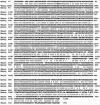Identification of coding sequences from a freshly prepared Trypanosoma brucei brucei expression library by polymerase chain reaction
- PMID: 23936738
- PMCID: PMC3729254
Identification of coding sequences from a freshly prepared Trypanosoma brucei brucei expression library by polymerase chain reaction
Abstract
Animal African trypanosomiasis (AAT) also known as Nagana is a devastating disease among domestic animals in large parts of Sub-Saharan Africa causing loses in milk and meat production as well as traction power. However, there is currently no commercial vaccine against AAT. The parasites have also developed resistance to some of the drugs in use. Moreover, the use of affordable computer-aided wet bench methods in the search for vaccine and/or new drug targets against this disease have not yet been fully explored in developing countries. This study, therefore, explored the use of PCR to screen a freshly prepared bloodstream form Trypanosoma brucei brucei (T. b. brucei) expression library for coding sequences followed by bioinformatics analyses specifying the functions and importance of these proteins to parasite survival. Eleven protein coding sequences were identified from twenty nine purified clones. The putative retro transposon hot spot protein 4 (RHSP 4) was the only protein with a fully annotated DNA sequence. All the others were hypothetical or had partial or unqualified annotations. RHSP 4 and pyruvate dehydrogenase E1 component, alpha sub-unit (PDE1α) are involved in aerobic respiration whereas succinyl-Co A-3-ketoacid-coenzyme A transferase mitochondrial precursor (SKTMP) is predicted to be involved in ketone body catabolism. Cystathionine beta-synthase (CBS) and alpha-1,3-mannosyltransferase (αMT) have been predicted in cysteine biosynthesis and vesicular transport respectively. The functions of the hypothetical proteins encountered have neither been experimentally determined nor predicted. We hypothesize that both CBS and PDE1α are good drug targets. Overall, about 300 plates are required to PCR screen the entire Trypanosoma brucei genome in approximately eight months. This method is therefore, applicable and affordable in the search for new drug targets under conditions of limited resources among developing countries.
Keywords: Nagana; PCR; bioinformatics; drug targets; expression library; proteins.
Figures











Similar articles
-
Transcript expression analysis of putative Trypanosoma brucei GPI-anchored surface proteins during development in the tsetse and mammalian hosts.PLoS Negl Trop Dis. 2012;6(6):e1708. doi: 10.1371/journal.pntd.0001708. Epub 2012 Jun 19. PLoS Negl Trop Dis. 2012. PMID: 22724039 Free PMC article.
-
Functional Analyses of Cytokinesis Regulators in Bloodstream Stage Trypanosoma brucei Parasites Identify Functions and Regulations Specific to the Life Cycle Stage.mSphere. 2019 May 1;4(3):e00199-19. doi: 10.1128/mSphere.00199-19. mSphere. 2019. PMID: 31043517 Free PMC article.
-
Evaluating the impact of targeting livestock for the prevention of human and animal trypanosomiasis, at village level, in districts newly affected with T. b. rhodesiense in Uganda.Infect Dis Poverty. 2017 Feb 6;6(1):16. doi: 10.1186/s40249-016-0224-8. Infect Dis Poverty. 2017. PMID: 28162093 Free PMC article.
-
Chemotherapeutic strategies against Trypanosoma brucei: drug targets vs. drug targeting.Curr Pharm Des. 2007;13(6):555-67. doi: 10.2174/138161207780162809. Curr Pharm Des. 2007. PMID: 17346174 Review.
-
Development of drug resistance in Trypanosoma brucei rhodesiense and Trypanosoma brucei gambiense. Treatment of human African trypanosomiasis with natural products (Review).Int J Mol Med. 2008 Oct;22(4):411-9. Int J Mol Med. 2008. PMID: 18813846 Review.
Cited by
-
Upregulation of Cysteine Synthase and Cystathionine β-Synthase Contributes to Leishmania braziliensis Survival under Oxidative Stress.Antimicrob Agents Chemother. 2015 Aug;59(8):4770-81. doi: 10.1128/AAC.04880-14. Epub 2015 Jun 1. Antimicrob Agents Chemother. 2015. PMID: 26033728 Free PMC article.
-
Deciphering the interplay between cysteine synthase and thiol cascade proteins in modulating Amphotericin B resistance and survival of Leishmania donovani under oxidative stress.Redox Biol. 2017 Aug;12:350-366. doi: 10.1016/j.redox.2017.03.004. Epub 2017 Mar 7. Redox Biol. 2017. PMID: 28288415 Free PMC article.
References
-
- Aksoy S. Control of tsetse flies and trypanosomes using molecular genetics. Vet Parasitol. 2003;115:125–45. - PubMed
-
- Ilemobade AA. Tsetse and trypanosomosis in Africa: the challenges, the opportunities. Onderstepoort J Vet Res. 2009;76:35–40. - PubMed
-
- Barry JD, McCulloch R. Antigenic variation in trypanosomes: enhanced phenotypic variation in a eukaryotic parasite. Adv Parasitol. 2001;49:1–70. - PubMed
-
- Vanhamme LE, Pays R, McCulloch R, Barry JD. An update on antigenic variation in African trypanosomes. Trends Parasitol. 2001;17:338–43. - PubMed
-
- Borst PW, Bitter PA, Blundell I, Chaves M, Cross H, Gerrits F, Van Leeuwen R, McCulloch M, Taylor M, Rudenko G. Control of VSG gene expression sites in Trypanosoma brucei . Mol Biochem Parasitol. 1998;91:67–76. - PubMed
LinkOut - more resources
Full Text Sources
Research Materials
Miscellaneous
